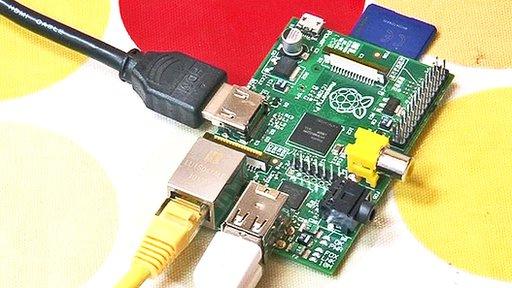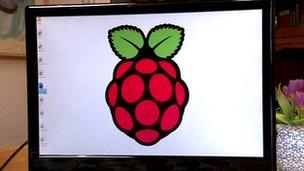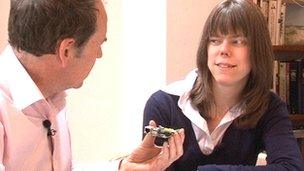Raspberry Pi computer review: 'a great step forward'
- Published
- comments

The Raspberry Pi runs off an operating system saved onto an attached SD memory card
The Raspberry Pi, a credit-card sized computer designed to encourage children to learn programming, caught the imagination of millions when it was unveiled in February.
The website where it was offered for sale crashed, and then there were delays in getting the product safety-tested.
Now, though, the first devices are beginning to be delivered to customers.
Mine arrived in the post a few days ago, so small that it came through the letterbox.
I wondered how to set about testing it and decided to invite a teenage programmer, Isabell Long, to come and help me out.
Getting started
18-year-old Isabell is studying for A-Levels, including computing, and is a leading light with Young Rewired State, the organisation which gets young people from all over the country together for hacking weekends.
Student Isabell Long tests the Raspberry Pi with Rory Cellan-Jones
The uncased device, with everything on show, may have great appeal to the experienced programmers who have rushed to order a Raspberry Pi.
But the device is aimed at children, who could be put off by the need to hunt down various peripherals and cable before you can get going.
After a bit of rummaging in the attic, I found what we needed - a television, an HDMI cable, a mouse, a keyboard, an ethernet cable, and a micro-USB charger to power the device.
Isabell and I found the instructions on plugging it all together pretty simple. The device arrived with an SD card loaded with a Linux operating system and various demos.
Then we turned it on, and watched with glee as lines of computer code scrolled up the screen and, after a moment of worrying blackness, a giant Raspberry Pi logo appeared.
Cartoons and crashes
We set off to explore the desktop, which includes a web browser and the XBMC open source media player.
We were impressed that this tiny machine could play out an HD movie, but after checking out the first minute or so of Big Buck Bunny, the cartoon that comes loaded on the SD card, we remembered the real function of the Raspberry Pi, teaching the joys of coding.

The Pi's operating system displays the organisation's logo on its desktop
There are two programming languages available to try on the Pi: Scratch and Python.
Scratch is designed to introduce younger children to programming, and is already used in a number of primary schools. Isabell found a demo racing car game, and showed me how simple it would be for children to change instructions in the program.
Next, we found the Python folder, aimed at slightly older students.
It came with a selection of games - the idea is you play them, then tinker with the code. We tried one, it froze, we then tried a number of keyboard commands to force it to quit, but nothing happened, so we had to reboot.
Then, after a bit of exploration, Isabell opened a Python window and tried out a line of code.
She typed in 'print "Hello!"', pressed return, and, lo and behold, the computer said "hello" back. One small step for coding...
Overall, after some initial confusion, we found it reasonably simple to get to grips with the Raspberry Pi, although there is still some work to be done before it is ready to be marketed direct to children and schools.
But at this point let me hand over to Isabell for her review:
It's an incredibly small, cheap computer that is perfect for bulk-buying for schools.
However, its components being so visible could put kids off - they're consumers, not programmers, at the moment, so seeing the electronics involved in what they use will either make them gasp in awe, or shy away in confusion or fear, and I think that its components are a vital part of its beauty.
This may be the perfect opportunity to push coding easily into the classroom, with the Pi's readily available installations of Scratch and Python, and may indeed encourage more girls to get involved if it is put into schools in the right way - proactively.
After all, kids tend to follow their friends: intrigue follows intrigue.

Isabell Long welcomes the fact that the Pi runs off an open source Linux system
As the operating system can only be put on an SD card, which has very limited capacity, they won't become mainstream Windows machines, and that will get Linux into schools. A great step forward.
Open outcome
The people behind this project say that it will be sold with a case, and the opportunity to buy a bundle of peripherals, when they start marketing it to children and schools.
But just a word of caution. Many school students - and indeed some ICT teachers - will not approach the Raspberry Pi with the same level of knowledge or enthusiasm as Isabell Long.
The device may inspire a new generation of computer programmers or it could leave children used to smartphones and tablet computers baffled and bewildered.
A great experiment with the way we teach computing has begun and we can't be sure how it will end.
- Published13 April 2012
- Published15 March 2012
- Published8 March 2012
- Published8 March 2012
- Published29 March 2012
- Published29 February 2012
- Published29 February 2012